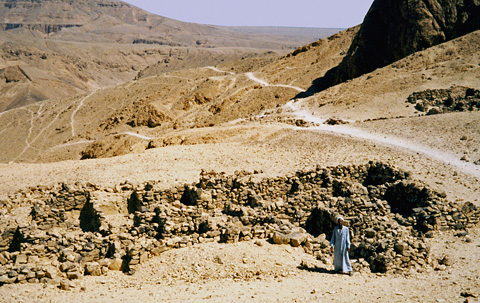The remit of the project is as follows:
'A multidisciplinary study on human agency, housing construction and social and ritual space in Egypt 1550-1069 BC with special focus on the 'Station de Repos' area [the 'Workmens' Huts']'.
The team are using the same numbering system that Bruyère established in the 1930's, and have split the excavation area into three sections: the Northern (worked on in 2008-9), Eastern (worked on in 2010) and Western (2011) clusters. The plan of the site made by the team differs slightly from the original plan by Bruyère and is more precise.
Dr. Toivari-Viitala split her lecture into two sections; the first presenting the archaeological setting of the huts within the context of the Theban landscape, and the second focussing on the finds from the site. Despite searing working temperatures - sometimes hitting 63°c - and often challenging working conditions dealing with the garbage which constantly accumulates at the site, the team have made some fascinating discoveries since 2008, including the following:-
- 141 stone huts have been found at the site by the team to date.
- The floors of the huts were often covered with a limestone plaster made from local stone.
- 'Mastabas', or benches, were a regular feature in the huts, which were normally between 20-30cm in height. The mastabas were typically marked out with large boulders and filled with loose earth and rubbish, and the whole mastaba was then covered with white plaster to make a smooth surface for sitting. One unusual rock-cut 'mastaba' was also found by the team, although the precise nature of this features remains questionable as it is also much taller than the other mastabas in the group (c. 70cm).
- Limestone slabs were also used as thresholds, and would have been placed over loose boulders and plastered.
- Fossilised shells, commonly found on the Theban hills, were used as fill for the walls of the huts.
- New Kingdom pottery were discovered as fill in the mastabas.
- Remnants of 20 fireplaces have been found both inside and outside the huts, identified by surviving ashes. New Kingdom and Coptic pottery have been found inside two of these fireplaces which proves that the site was also utilised during the Coptic Period.
- A partly-finished bundle of textile rags containing 27 lamp wicks has also been discovered, together with used pottery lamps.
- A small shrine with a single central room has been identified with two unusual small spaces at each side, what Dr. Toivari-Viitala referred to as 'dummy spaces', which seem to be too shallow for storage. There are also roughly-cut hieroglyphic graffiti on the rock-cut steps at the edge of the shrine.
--------------
But the precise motivation for the construction of the huts remains a mystery. Some ideas concerning the site's function were debated by the audience:-
1. Game boards and gaming pieces have been found, which some members of the audience suggested might be evidence of the huts being used as a 'gentleman's club' - a place for the husbands to have a break from their wives who lived at Deir el-Medina.
2. Was it a purely administrative area for the workmen to check the tools in and out on the way to and from the Valley of the Kings? Evidence of the well known scribe Qenherkhepeshef (temp. Ramesses II) at the site, including three rooms which he used, may support this theory, but then why the gaming boards? Were they simply used while the administrative staff at the huts were bored or had time to kill?
3. The big question still remains that after the workmen had finished their daily work in the Valley of the Kings, it must have been more difficult to walk up to the top of the mountain to the huts, than to walk down to Deir el-Medina at the bottom of the mountain, and wouldn't they rather have wanted to go home if they were already halfway there? That the northern wind is quite strong at the site may suggest that it was used as a halfway point during the very hot summer months.
Dr. Toivari-Viitala presented a compelling argument but it is clear that the precise function of the site is yet to by fully established. However, it was fascinating to hear more about the work of the team, particularly to see some of the finds from previous seasons, and certainly a great day was had by all. A great benefit was that many of the audience had previously visited the site and walked over the Theban hills from Deir el-Medina to the Valley of the Kings, so the discussion was particularly engaging. I look forward to hearing more after next season to see whether more tantalising details are revealed, and would welcome any comments if readers have any further ideas to contribute!
 I am gradually making my way around the Egyptianising monuments of London during my time in the city working at the British Museum. My most recent visit was to Kensal Green Cemetery as part of a guided tour organised by ASTENE (Association for the Study of Travel in Egypt and the Near East) led by Cathie Bryan, who also led the excellent 'Cinematic Necropolis' tour organised by the Petrie Museum which I attended in June 2012.
I am gradually making my way around the Egyptianising monuments of London during my time in the city working at the British Museum. My most recent visit was to Kensal Green Cemetery as part of a guided tour organised by ASTENE (Association for the Study of Travel in Egypt and the Near East) led by Cathie Bryan, who also led the excellent 'Cinematic Necropolis' tour organised by the Petrie Museum which I attended in June 2012.














